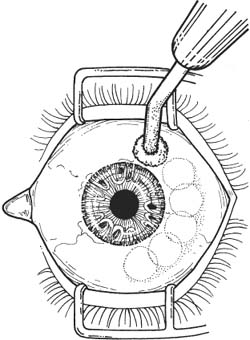32 See Chapter 3. 1. Topical steroids (e.g., prednisolone acetate 1%) as indicated to decrease inflammation. 2. Cycloplegia (e.g., atropine 1% twice daily) in painful eyes. 3. Glaucoma medications are continued up to the time of the procedure to diminish postoperative rise in IOP. 4. Administer a topical nonsteroidal anti-inflammatory drug (NSAID) (e.g., flurbiprofen 0.03% [Ocufen, Allergan, Inc., Irvine, CA, US]) to inhibit postoperative prostaglandin release. 1. Anesthesia: a. Peribulbar or retrobulbar with lid block if necessary. b. General anesthesia in uncooperative patient. 2. Optional: In a blind painful eye, retrobulbar alcohol may be injected for long-lasting anesthesia (see Chapter 4). 3. Prep and drape. 4. Place lid speculum. 5. Test cryosurgical unit. (The optimal treatment temperature is ~80 degrees centigrade.) 6. Plan number and position of applications. a. Measuring with calipers, place anterior edge of cryo-probe 1.0 to 1.5 mm from anterior border of limbus (e.g., centered directly over pars plicata). b. Separate spots by 1 clock hour. c. Titrate number of applications to desired pressure-lowering effect. A typical treatment covers 6 to 9 clock hours (180–270 degrees). This number should rarely be exceeded, as the risk of complications increases with more applications. Figure 32.1 7. Apply cryoprobe and perform treatment (Fig. 32.1). a. Press cryoprobe firmly over desired position, indenting sclera. b. Activate cryo-unit. c. Observe development of iceball and decrease in cryoprobe temperature to at least 60 degrees centigrade (−80°C is optimal). d. Maintain freezing application for 60 seconds. e. Iceball should extend to limbus but not too far over clear cornea. 8. Stop the freeze and irrigate the tip of the probe at the end of each application to facilitate its removal from the globe. 9. Apply topical antibiotic and steroid ointment. 10. Place patch. 1. Control inflammation. a. Topical steroids (e.g., prednisolone acetate 1%) every 1 to 2 hours and taper as inflammation warrants. b. Oral steroids if inflammation is severe. c. NSAIDs to inhibit prostaglandin release. 2. Control pain and discomfort. a. Cycloplegia (e.g., atropine 1% twice daily). b. NSAID. c. Narcotics as needed. d. Antiemetics as needed. 3. Control IOP. a. Continue glaucoma medications postoperatively, as hypotensive effect of cyclocryotherapy may take several days to develop. b. Measure IOP 4–6 hours postoperatively and daily thereafter until stable. c. If IOP increases, the following may be added to the medical regimen. i. Osmotics (e.g., mannitol 20% intravenously or oral hyperosmotics). Note: Some surgeons routinely administer mannitol postoperatively to prevent pressure spike. ii. Carbonic anhydrase inhibitors (e.g., dorzolamide hydrochloride 2% [Trusopt, Merck & Co., Inc., Whitehouse Station, NJ, US]) 3 times per day or Diamox sequels 500 mg orally 2 times per day. iii. β-blockers (e.g., timolol maleate 0.5% 2 times a day). iv. α-agonists (e.g., brimonidine tartrate 0.10% [Alphagan P, Allergan, Inc.]) 2 or 3 times per day. d. Repeat cyclocryotherapy if IOP is not satisfactorily controlled with medication. i. Wait at least 1 month before repeating treatment to allow time for the full effect of initial treatment to be manifested. ii. When performing repeat cyclocryotherapy, may re-treat the initial sites first in an attempt to avoid overtreatment, hypotony, and consequent phthisis. Additional spots may be cautiously added if deemed necessary for adequate pressure control. However, total treatment of more than 300 degrees is rarely, if ever, indicated. 1. Severe ocular pain 2. Inflammation 3. Transient increase in IOP 4. Macular edema 5. Suprachoroidal effusion or hemorrhage 6. Hyphema (especially in eye with neovascular glaucoma) 7. Vitreous bleeding 8. Hypotony and phthisis bulbi 9. Cataract 10. Dellen and limbal scars 11. Staphyloma 12. Anterior segment necrosis
Cyclodestructive Procedures
 Cyclocryotherapy
Cyclocryotherapy
Indications
 Treatment of glaucoma that has failed multiple procedures (e.g., filtration, cyclodialysis, or tube/shunt procedures), especially in aphakic or pseudophakic eyes
Treatment of glaucoma that has failed multiple procedures (e.g., filtration, cyclodialysis, or tube/shunt procedures), especially in aphakic or pseudophakic eyes
 Control of increased intraocular pressure (IOP) in eyes with poor potential for good central acuity
Control of increased intraocular pressure (IOP) in eyes with poor potential for good central acuity
 As a possible alternative to enucleation or evisceration of an eye that is blind and painful because of secondary glaucoma.
As a possible alternative to enucleation or evisceration of an eye that is blind and painful because of secondary glaucoma.
Preoperative Procedure
Instrumentation
 Lid speculum (e.g., Lieberman)
Lid speculum (e.g., Lieberman)
 Castroviejo calipers
Castroviejo calipers
 Cryosurgical unit with glaucoma cryoprobe (2.5 mm diameter tip)
Cryosurgical unit with glaucoma cryoprobe (2.5 mm diameter tip)
Operative Procedure
Postoperative Procedure
Complications
 Laser Cyclophotocoagulation
Laser Cyclophotocoagulation
Indications
 Treatment of glaucoma that has failed multiple procedures (e.g., filtration, cyclodialysis, or tube/shunt procedures), especially in aphakia or pseudophakia.
Treatment of glaucoma that has failed multiple procedures (e.g., filtration, cyclodialysis, or tube/shunt procedures), especially in aphakia or pseudophakia.
 Control of increased IOP in eyes with poor potential for good central visual acuity.
Control of increased IOP in eyes with poor potential for good central visual acuity.
Stay updated, free articles. Join our Telegram channel

Full access? Get Clinical Tree



